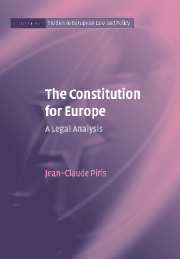Book contents
- Frontmatter
- Contents
- List of figures
- List of tables
- List of boxes
- Series editors' preface
- Acknowledgments
- Table of cases
- List of annexes
- Introduction
- 1 Is The constitution for Europe ‘dead and buried’?
- 2 The process that led to the Constitution
- 3 Changes in structures and procedures
- 4 Changes in the institutions
- 5 Changes in substance
- 6 General Assessment
- Conclusion what will the final form of the union be?
- List of annexes
- Table of equivalences between the provisions of the Treaty establishing a Constitution for Europe and the provisions of the EU and EC Treaties
- List of ‘passerelles’ and provisions on a simplified revision procedure
- Table of references
- Index
Conclusion what will the final form of the union be?
Published online by Cambridge University Press: 04 August 2010
- Frontmatter
- Contents
- List of figures
- List of tables
- List of boxes
- Series editors' preface
- Acknowledgments
- Table of cases
- List of annexes
- Introduction
- 1 Is The constitution for Europe ‘dead and buried’?
- 2 The process that led to the Constitution
- 3 Changes in structures and procedures
- 4 Changes in the institutions
- 5 Changes in substance
- 6 General Assessment
- Conclusion what will the final form of the union be?
- List of annexes
- Table of equivalences between the provisions of the Treaty establishing a Constitution for Europe and the provisions of the EU and EC Treaties
- List of ‘passerelles’ and provisions on a simplified revision procedure
- Table of references
- Index
Summary
My personal point of view is that the European Union already is, and will remain in the future, a ‘Partially Federal Union’. This means that the EU is not a federal State and that, in the foreseeable future, it will not become one.
If considered against the classic definition of a State: a people, a territory, an organised government, full sovereignty, the right and means of control over all persons and things within its borders, the capacity for making war and peace and for entering into international relations with other States, the EU does not comply with some or all of these criteria.
Moreover, the EU lacks most of the essential means usually associated with the notion of a State. It lacks proper financial resources and power directly to collect taxes. It is not allowed to establish its own resources, which are laid down in a Decision to be ratified by Member States. The EU budget represents only a tiny proportion of the gross domestic product of the Member States (approximately 1%) and the vast bulk of its expenses (around 85%) is managed by the Member States' administrations. The EU lacks administrative and technical capacities. Its administrative expenditure is less than 5% of its total budget and the human resources of its central organs (about 30,000 people) represent about half of the municipal staff of the city of Paris.
- Type
- Chapter
- Information
- The Constitution for EuropeA Legal Analysis, pp. 192 - 197Publisher: Cambridge University PressPrint publication year: 2006

